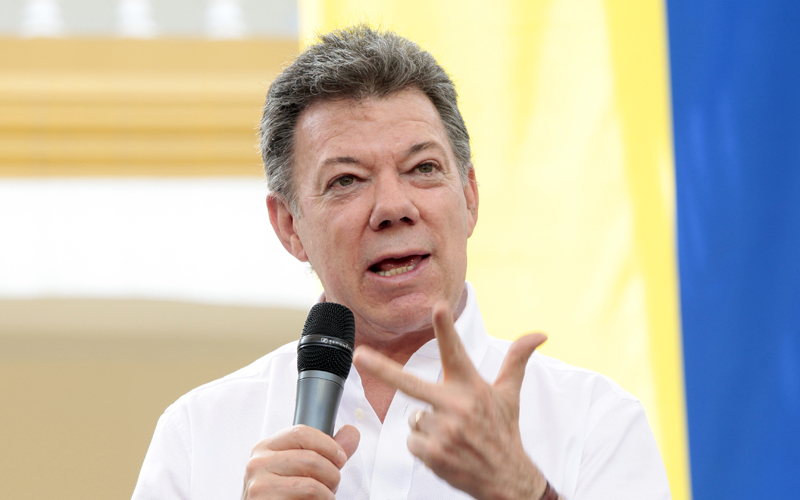
The Elusive Road to Peace in Colombia
Colombian President Santos staked his job on finalizing a peace agreement with the FARC guerrillas. Voters rewarded him with a mandate in June’s run-off election, giving him a decisive victory over right-wing challenger Oscar Zuluaga. As the handpicked candidate of former President Uribe, Zuluaga campaigned on suspending negotiations with the FARC. Santos has promised to bring the 50-year-old conflict to an end by 2015. This may be Colombia’s best chance for peace in more than a decade.
Two years into the current round of talks, negotiators have reached agreement on three of six points on the agenda: providing land reserves to peasant farmers, a plan to integrate FARC into Colombia’s political system, and a strategy to combat drug trafficking. The final round will focus on demobilizing the FARC, reparations for war victims, and assigning criminal penalties for its leaders.
Santos has made key concessions by allowing the FARC to organize a political party and arranging new protected land for farmers — proposals fiercely contested by conservatives in Congress. In return, the FARC has agreed to stop trafficking drugs (its largest source of revenue), but must now disarm and account for its crimes against the civilian population — issues the group has consistently failed to address.
The talks are a litmus test for the FARC, an opportunity to prove that they are a legitimate force in Colombian politics.
Both sides have an incentive to move quickly. Santos hopes to translate Colombia’s economic gains into first-world status, while the FARC’s leaders, who face extradition to the United States on drug trafficking charges, wish for their status to be resolved. Washington has invested millions in attempting to stop the drug trade, supplying Colombia’s military with arms, training, and specialized equipment to help fumigate coca crops. The White House wants to ensure that the FARC’s penalty fits its crimes.
The economy has boomed since Santos first took office in 2010. Colombia is growing at the second-fastest rate in South America (behind Peru), and recently became the continent’s third-largest economy. Foreign investors pumped $16 billion into the country in 2013. First quarter growth was strong enough to prompt the Central Bank to tighten monetary policy, raising interest rates in June for the third straight month. Santos has publicly stated that a peace deal could boost growth by around 2 percent per year.
Though Colombia’s military is clearly a superior force, the FARC retains 8,000 active fighters and continues to disrupt economic activity. Attacks on oil pipelines have forced a reduction in projected petroleum output by approximately 10 percent, to just under a million barrels per day. Drug violence regularly spills into Colombia’s border region with Panama and has historically flowed into Venezuela, which has served as a base of operations for the militants. Those relationships remain testy, but Colombia’s willingness to lead joint operations against the FARC in the Darien Gap and the Venezuelan Amazon has helped ease tension with its neighbors.
For the FARC, apologizing to the families of victims remains a major sticking point in the talks; negotiators will have to find a way for the guerrillas to repent for their crimes in a dignified manner. The public wants the conflict to come to an end and polls show that the vast majority of Colombians support a peace deal.
Yet, creating peace with the FARC will not solve all of Colombia’s problems. Colombia is plagued with economic inequality, which Santos hopes to mitigate by redistributing royalty payments from mining and oil revenues to lower-income citizens. He will have to get that idea past Uribe’s allies in Congress, who gained seats in both houses in June. Santos is also attempting to reduce corruption: he has proposed stricter term limits on judges and future presidents, making re-election campaigns illegal and extending the term of the country’s highest office to five or six years.
Santos also faces the difficult task of finding a place in Colombian society for thousands of hardened FARC veterans. The government’s Agency for Reintegration is offering defectors relocation, three months of space in makeshift “peace homes,” a small cash stipend, coursework and basic life skills training to get them on the right path. That program will need more funding and resources to ensure that the hundreds of guerrillas hanging up their weapons each month are fully prepared to enter the job market.
Not since 1948, when the assassination of a presidential candidate sparked a decade of violence, has Colombia faced such a defining moment for its future. Should a deal be struck the country can begin to heal its internal divisions, normalize its relations with Panama and Venezuela, rebuild its reputation as a secure tourist-friendly destination, and complete additional trade pacts. When peace comes to Colombia, it will also be better poised to assume a position of regional leadership. Santos and the FARC should seize the moment.
This article was originally posted in The Huffington Post.

